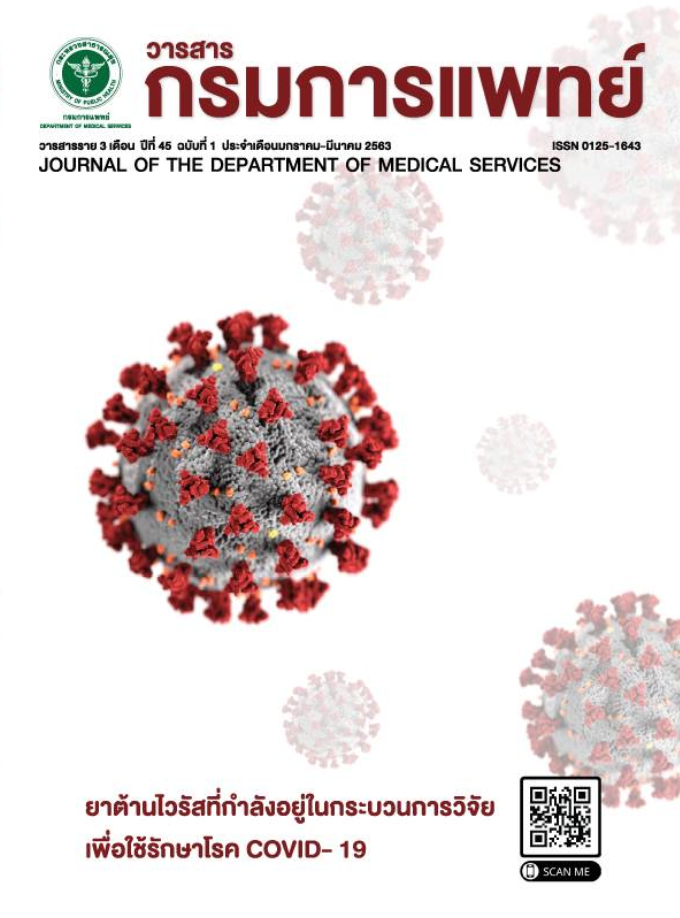Medical Role in Proving Child Abuse in the Head
Abstract
การบาดเจ็บศีรษะจากการทารุณกรรมเป็นสาเหตุการตาย และทุพพลภาพของเด็กเล็กโดยเฉพาะในเด็กอายุน้อยกว่า 1 ปี เด็กที่ถูกทารุณกรรม แรกรับมักมีอาการที่ไม่จำเพาะ เช่น อาเจียน ซึม ร้องกวน หรือทานน้อย นำไปสู่การวินิจฉัยที่ล่าช้า จึงพบการวินิจฉัยแรกรับที่ผิดพลาดได้ถึงร้อยละ 31 โดยเด็กร้อยละ 28 ที่วินิจฉัยผิดพลาดจะถูกทารุณกรรมซ้ำจนบางรายเสียชีวิต ทั้งนี้หากแพทย์วินิจฉัยการถูกทารุณกรรมที่ศีรษะได้เร็วจะสามารถรักษาชีวิตเด็กได้ในรายที่ผู้ดูแลไม่แจ้งประวัติการทำร้าย หากผู้ป่วยเด็กมีความรู้สึกตัวลดลง หรือหยุดหายใจ แพทย์ควรคิดถึงภาวะเด็กถูกเขย่า (Shaken Baby Syndrome, SBS) หรือ การบาดเจ็บศีรษะจากถูกทารุณกรรม (Abusive Head Trauma, AHT) ซึ่งเกิดได้จากการถูกเขย่า ทุบตี เหวี่ยง หรือโยน ทำให้กลไกการบาดเจ็บเกิดได้หลายแบบ ในกรณีที่มีการทารุณกรรมอย่างรุนแรง อาจมีอาการชัก สายตาพร่ามัว ตาบอด และสติปัญญาบกพร่องในระยะยาว ปัจจัยที่ก่อให้เกิดการทารุณกรรม เช่น การเลี้ยงดูโดยพ่อแม่อายุน้อย พ่อแม่เลี้ยงเดี่ยว การอยู่กับพ่อเลี้ยงแม่เลี้ยง ความเครียด ภาวะซึมเศร้า ความรุนแรงในครอบครัว และการใช้สารเสพติดหรือแอลกอฮอล์ การร้องไห้ไม่หยุดของเด็กเป็นตัวกระตุ้นให้เกิดการทารุณกรรมซึ่งผู้กระทำมักให้การว่าใช้การเขย่าเป็นวิธีที่ทำให้เด็กหยุดร้อง เนื่องจากผู้ดูแลเด็กมักปกปิดเหตุการณ์ที่เกิดขึ้น ดังนั้นแพทย์ พยาบาลที่รับตัวเด็กไว้ในสถานพยาบาลควรจะทราบอาการ อาการแสดง ที่ทำให้สงสัยเด็กถูกทารุณกรรม ทำการส่งตรวจเพิ่มเติม และวินิจฉัยการบาดเจ็บได้อย่างถูกต้อง เพื่อให้ได้ข้อเท็จจริงในการคุ้มครองสวัสดิภาพ และเกิดประโยชน์ต่อกระบวนการยุติธรรม
References
Ricci L, Giantris A, Merriam P, Hodge S, Doyle T. Abusive head trauma in Maine infants: medical, child protective, and law enforcement analysis. Child Abuse Negl 2003;27:271–83.
Choudhary AK, Servaes S, Slovis TL, Palusci VJ, Hedlund GL, Narang SK, et al. Consensus statement on abusive head trauma in infants and young children. Pediatr Radiol 2018;48:1048–65.
Stiffman MN, Schnitzer PG, Adam P, Kruse RL, Ewigman BG. Household composition and risk of fatal child maltreatment. Pediatrics 2002;109:615–21.
Keenan HT, Runyan DK, Marshall SW, Nocera MA, Merten DF. A population-based comparison of clinical and outcome characteristics of young children with serious inflicted and noninflicted traumatic brain injury. Pediatrics 2004 ;114:633–9.
Hettler J, Greenes DS. Can the initial history predict whether a child with a head injury has been abused? Pediatrics 2003;111:602–7.
Adamsbaum C, Grabar S, Mejean N, Rey-Salmon C. Abusive head trauma: judicial admissions highlight violent and repetitive shaking. Pediatrics 2010;126:546–55.
Caffey J. The whiplash shaken infant syndrome: manual shaking by the extremities with whiplashinduced intracranial and intraocular bleedings, linked with residual permanent brain damage and mental retardation. Pediatrics 1974;54:396–403.
Vinchon M, Defoort-Dhellemmes S, Desurmont M, Dhellemmes P. Accidental and nonaccidental head injuries in infants: a prospective study. J Neurosurg 2005;102:380–4.
Richards PG, Bertocci GE, Bonshek RE, Giangrande PL, Gregson RM, Jaspan T, et al. Shaken baby syndrome. Arch Dis Child 2006;91:205–6.
Harding B, Risdon RA, Krous HF. Shaken baby syndrome. BMJ 2004;328:720–1.
Bhoopat T, Sribanditmongkol P. Head injuries. In: Wunnapuk K, Wichairat K. Editors. Forensic medicine and forensic medicine practice. Chiang Mai: Department of Forensic Science Faculty of Medicine Chiang Mai University; 2550.
Finnie JW, Blumbergs PC, Manavis J, Turner RJ, Helps S, Vink R, et al. Neuropathological changes in a lamb model of non-accidental head injury (the shaken baby syndrome). J Clin Neurosci 2012;19:1159–64.
Ichord RN, Naim M, Pollock AN, Nance ML, Margulies SS, Christian CW. Hypoxic-ischemic injury complicates inflicted and accidental traumatic brain injury in young children: the role of diffusionweighted imaging. J Neurotrauma 2007 ;24:106–18.
Ommaya AK, Gennarelli TA. Cerebral concussion and traumatic unconsciousness. Correlation of experimental and clinical observations of blunt head injuries. Brain 1974;97:633–54.
Nimityongskul P, Anderson LD. The likelihood of injuries when children fall out of bed. J Pediatr Orthop 1987;7:184–6.
Helfer RE, Slovis TL, Black M. Injuries resulting when small children fall out of bed. Pediatrics 1977;60:533–5.
Tarantino CA, Dowd MD, Murdock TC. Short vertical falls in infants. Pediatr Emerg Care 1999;15:5–8.
Kivlin JD, Simons KB, Lazoritz S, Ruttum MS. Shaken baby syndrome. Ophthalmology 2000; 107:1246.
Piteau SJ, Ward MGK, Barrowman NJ, Plint AC. Clinical and radiographic characteristics associated with abusive and nonabusive head trauma: a systematic review. Pediatrics 2012;130:315–23.
Maguire SA, Watts PO, Shaw AD, Holden S, Taylor RH, Watkins WJ, et al. Retinal haemorrhages and related findings in abusive and non-abusive head trauma: a systematic review. Eye (Lond) 2013;27:28–36.
Agrawal S, Peters MJ, Adams GGW, Pierce CM. Prevalence of retinal hemorrhages in critically ill children. Pediatrics 2012 ;129:1388-96.
Wichairat K. Clinical forensic medicine. In: Wunnapuk K, Wichairat K. Editors. Forensic medicine and forensic medicine practice. Chiang Mai: Department of Forensic Science Faculty of Medicine Chiang Mai University; 2550.
Downloads
Published
How to Cite
Issue
Section
License
บทความที่ได้รับการตีพิมพ์เป็นลิขสิทธิ์ของกรมการแพทย์ กระทรวงสาธารณสุข
ข้อความและข้อคิดเห็นต่างๆ เป็นของผู้เขียนบทความ ไม่ใช่ความเห็นของกองบรรณาธิการหรือของวารสารกรมการแพทย์



